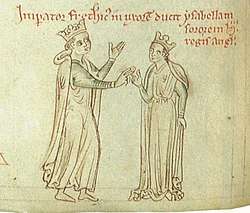Isabella of England
Isabella of England (1214 – 1 December 1241) was Holy Roman Empress, Queen of the Germans, and queen consort of Sicily.
| Isabella of England | |
|---|---|
 | |
| Holy Roman Empress; Queen consort of Sicily | |
| Tenure | 15 July 1235 – 1 December 1241 |
| German Queen | |
| Tenure | 15 July 1235 – May 1237 |
| Born | 1214 Gloucester, England |
| Died | 1 December 1241 (aged 26–27) Foggia, Apulia, Italy |
| Burial | Andria Cathedral, Italy |
| Spouse | Frederick II, Holy Roman Emperor |
| Issue | Margaret of Sicily |
| House | Plantagenet |
| Father | King John of England |
| Mother | Isabella of Angoulême |
She was the fourth child and second daughter of John, King of England and Isabella of Angoulême.
Life
At a friendly meeting at Rieti, Pope Gregory IX suggested to Emperor Frederick II that he marry princess Isabella, a sister of King Henry III of England. At first Frederick II was concerned to lose his French allies; but when he realized that an English marriage might end the ongoing Anglo-French feud and constitute an important step towards the restoration of peace in Western Christendom, thus smoothing the way for a successful crusade, he agreed. The betrothal was formalized in London in February 1235.
Her brother Henry had to levy an unpopular tax of two marks of silver per hide in order to afford the thirty thousand marks Frederick insisted on as Isabella's dowry. Frederick sought this large amount to help fund his wars in northern Italy.[1]

The beautiful Isabella was about twenty-one years old when she set out to marry the twice-widowed Emperor Frederick II, who was forty. On her way through Cologne, she delighted the local women when she removed the traditionally worn veil so that they could see her face.
The marriage between Isabella and Frederick took place in Worms Cathedral on 15 or 20 July 1235; in the ceremony, she was also crowned Holy Roman Empress, Queen of Germany and Sicily. She was granted the castle of Monte Sant'Angelo by her husband upon her marriage.
However, as soon as she was married she was added to the Emperor's harem, which included women from Arabia[2] attended by black eunuchs. Their marriage had been a political match, and she was allowed to keep only two of her English women-attendants, Margaret Biset, who probably had been her nurse, and her maid Kathrein; the others were sent home.
Isabella lived in retirement at Noventa Padovana where her husband regularly visited her. When her brother, Richard, Earl of Cornwall, returned from the crusades, he was allowed to visit her, although Isabella was not allowed to be present at the official reception. While the imperial court resided at Foggia, Isabella gave birth to her last child and died. She is buried beside Frederick's previous wife, Queen Isabella II of Jerusalem, in Andria Cathedral, near Bari.
Issue
Primary sources are at variance concerning Isabella's issue, including the number of children she had, their names, and their birth order. What is known for sure is that Isabella had at least four children: a son who died shortly after his birth in 1236 or 1241, a daughter who – like her older brother – died shortly after her birth in 1237, Margaret, and Heinrich. Margaret is believed by some to have been the first child, and by others to be the child whose birth caused Isabella's death. The most common belief is that Margaret was the last child. The short-lived son of Isabella has been given the name of Frederick, Jordanus/Jordan, and Carl Otto by various sources. Some historians believe Isabella actually had five children, two short-lived sons instead of one, and that they were named Jordanus/Carl Otto and Frederick, the two being born in spring 1236 and summer 1240, respectively.
- Jordanus (born during the Spring of 1236, failed to survive the year);[3] this child received his name because was baptized with water brought for that purpose from the Jordan river.
- Agnes (b and d. 1237).
- Henry (18 January 1238 – May 1254); appointed Governor of Sicily and promised to become King of Jerusalem after his father died, but he, too, died within three years and was never crowned. Betrothed to many of Pope Innocent IV's nieces, but never married to any.
- Margaret (1 December 1241 – 8 August 1270), married Albert II, Margrave of Meissen.
Ancestors
| Ancestors of Isabella of England | |||||||||||||||||||||||||||||||||||||||||||||||||||||||||||||||||||||||||||||||||||||||||||||||||||||||||||||||||||||||||||||||||||||||||||||||||||||||||||||||||||||||||||||||||||||||||||||||||||||||||||||||||||||||||||||||||||||||||||||||||||||||||||||||||||||||||||||||||||||||||
|---|---|---|---|---|---|---|---|---|---|---|---|---|---|---|---|---|---|---|---|---|---|---|---|---|---|---|---|---|---|---|---|---|---|---|---|---|---|---|---|---|---|---|---|---|---|---|---|---|---|---|---|---|---|---|---|---|---|---|---|---|---|---|---|---|---|---|---|---|---|---|---|---|---|---|---|---|---|---|---|---|---|---|---|---|---|---|---|---|---|---|---|---|---|---|---|---|---|---|---|---|---|---|---|---|---|---|---|---|---|---|---|---|---|---|---|---|---|---|---|---|---|---|---|---|---|---|---|---|---|---|---|---|---|---|---|---|---|---|---|---|---|---|---|---|---|---|---|---|---|---|---|---|---|---|---|---|---|---|---|---|---|---|---|---|---|---|---|---|---|---|---|---|---|---|---|---|---|---|---|---|---|---|---|---|---|---|---|---|---|---|---|---|---|---|---|---|---|---|---|---|---|---|---|---|---|---|---|---|---|---|---|---|---|---|---|---|---|---|---|---|---|---|---|---|---|---|---|---|---|---|---|---|---|---|---|---|---|---|---|---|---|---|---|---|---|---|---|---|---|---|---|---|---|---|---|---|---|---|---|---|---|---|---|---|---|---|---|---|---|---|---|---|---|---|---|---|---|---|---|---|---|
| |||||||||||||||||||||||||||||||||||||||||||||||||||||||||||||||||||||||||||||||||||||||||||||||||||||||||||||||||||||||||||||||||||||||||||||||||||||||||||||||||||||||||||||||||||||||||||||||||||||||||||||||||||||||||||||||||||||||||||||||||||||||||||||||||||||||||||||||||||||||||
Footnotes
- Goldstone 2007, p. 44.
- Goldstone 2007, p. 43-44.
- Thomas Curtis Van Cleve's The Emperor Frederick II of Hohenstaufen: Immutator Mundi (Oxford, 1972). Page 381:"Certainly there is some evidence that a son, Jordanus, was born in the year 1236, and died shortly afterwards, but the only son of Frederick II and Isabella of England whose birth can be firmly established was a second Henry, born in 1238, and named after his uncle, Henry III, the King of England." Ref supplied by Peter Stewart via soc.gen.med 20 Jan 2008
References
- Alio, Jacqueline (2018). Queens of Sicily 1061-1266. New York: Trinacria. ISBN 9781943639144.
- Goldstone, Nancy (2007). Four Queens: The Provençal Sisters who ruled Europe. New York: Viking Penguin. ISBN 9780670038435.
- Tuchman, Barbara W. (1978), A Distant Mirror: the Calamitous 14th Century., Alfred A. Knopf, New York, 1984. ISBN 0-394-40026-7.
- Weir, Alison (2002). Britain's Royal Family: A Complete Genealogy. The Bodley Head London, U.K. ISBN 0-7126-4286-2. pages 70 & 71
- (in Italian) https://web.archive.org/web/20140130144602/http://www.stupormundi.it/Mogli.htm
| German royalty | ||
|---|---|---|
| Preceded by Margaret of Austria |
Queen consort of Germany 1235–1237 |
Succeeded by Elisabeth of Bavaria |
| Preceded by Isabella II of Jerusalem |
Queen consort of Sicily 1235–1241 | |
| Holy Roman Empress 1235–1241 |
Succeeded by Margaret II of Hainault | |